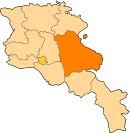Artsvashen
Artsvashen
Արծվաշեն Başkənd | |
|---|---|
 Lake near Artsvashen | |
 Artsvashen | |
| Coordinates: 40°38′46″N 45°30′56″E / 40.64611°N 45.51556°ECoordinates: 40°38′46″N 45°30′56″E / 40.64611°N 45.51556°E | |
| Country | |
| Province District | Gegharkunik (de jure) Gadabay (de facto) |
| Founded | 1845 |
| Area | |
| • Total | 40 km2 (20 sq mi) |
| Population (2009) | |
| • Total | 127 |
| Time zone | UTC+4 (AMT) |
| Artsvashen at GEOnet Names Server | |
Artsvashen (Armenian: Արծվաշեն, lit. 'Eagle City') is a de jure Armenian village in the Gegharkunik Province of Armenia. It is a 40 square kilometres exclave of Armenia,[1] and it is completely surrounded by the territory of Azerbaijan and has been de facto controlled by it since the First Nagorno-Karabakh War.
History[]
The present village was founded in 1854 as Bashkend (Armenian: Բաշքենդ) by Armenians from Choratan in Shamshadin, although an earlier Armenian presence on the site is attested by an inscription dated to 1607 on the Surb Hovhannes church in the town. It was later changed to Hin Bashkend (Armenian: Հին Բաշքենդ), meaning Old Bashkend to differentiate it from New or Nor Bashkend, founded by migrants from the original settlement.
In May 1991, during the First Nagorno-Karabakh War, the Armenian Interior Ministry reported that residents of Artsvashen had averted an army occupation by surrendering their arms.[2] Seen from the Azerbaijani perspective, however, the town became a major headache, blocking access to Shinikh and providing a launching point for military incursions against Azerbaijan's Gadabey province.
After Armenian attacks on Mutudərə and Qasımağalı in the Shinikh area to the west, the Azerbaijanis counter attacked under locally famed commander Cahangir Rüstəmov, whose regiment blockaded Artsvashen. On August 8, 1992 the Armenian defenders decided to surrender.[3] Artsvashen villagers were mostly given alternative shelter in the town of Chambarak whose former Molokan-Russian population had largely left for Russia. According to The New York Times, on 9 August 1992 Azerbaijani side announced that armed forces had "liberated" the town, destroying enemy tanks and weaponry and killing 300 Armenian "brigands", while Armenian reports mentioned no dead but said 29 people were "missing without trace."[4]
Accusing Azerbaijan of mounting an "undeclared war," Armenian President Levon Ter-Petrosyan sent a telegram to leaders of the Commonwealth of Independent States saying that "aggression has been committed against a state that is a member of the C.I.S. and the system of collective security".[4]
The village was swiftly renamed to its settler name Bashkend (Azerbaijani: Başkənd).[5] Today, the village is largely abandoned as the Azerbaijani army expelled its Armenian population after it captured the territory,[6] and is now administered by Azerbaijan as part of the Gadabay District.
Compensation claims[]
In 2009, former residents of Artsvashen village that were still residents of Chambarak nearly 20 years later were promised six billion drams of Armenian government compensation for their lost property. Two payments of 50 million drams then, in 2011, a bigger one of 708 million drams was given out in 2011, with around 2000 people getting about 360 thousand drams each. However, further payments stalled leading to protests in September 2018 and December 2019, demanding further funds to repair the dilapidated housing stock in Chambarak. Armenian premier Pashinyan claimed that the state had fulfilled all its obligations to refugees with money already disbursed and with the provision of housing certificates to about 112 families. [7]
Artsvashen carpets[]
In the Soviet times there was a branch of Haygorg ("Armenian carpet" state company) in Artsvashen.[8] After the capture of Artsvashen by the Azerbaijani forces, the residents of Artsvashen migrated to Shorzha, Vardenis, Abovyan and Chambarak, where they continued traditions of this art:
"The women of Artsvashen learned carpet weaving from their mothers and grandmothers. Many of them had worked for Haygorg for decades. “It was shameful for a girl or woman in Artsvashen not to be able to weave carpets. Even if they didn’t work for Haygorg, they would have a weaving stand at home and make carpets,”
said Irina Ghalechyan, a former resident of Artsvashen and carpet weaver."[8]
Gallery[]

Scenery around Artsvashen
Map of Artsvashen
Notable people[]
- Aramais Sahakyan, Armenian poet[9]
- Saribek Chilingaryan, Hero of the Soviet Union[citation needed]
See also[]
- Barkhudarli
- Yukhari Askipara
- Karki (Azerbaijan)
- List of enclaves and exclaves
References[]
- ^ Azerbaijan, by Human Rights Watch/Helsinki Org., 1994
- ^ Soviet Army Is Reported to Attack And Occupy 2 Armenian Villages, The New York Times, May 10, 1991
- ^ ArmInfo report 2019
- ^ Jump up to: a b Armenia Seeks Help in Fighting Azerbaijan, The New York Times, August 10, 1992
- ^ [1][dubious ]
- ^ Azerbaijan Seven Years of Conflict in Nagorno-Karabakh, Christopher Panico, Human Rights Watch, Jemera Rone (1994), p.92
- ^ Naira Badalian's 2019 article on protests
- ^ Jump up to: a b Carpet Weaving in Armenia, Lena Nazaryan, Hetq Online, 17/9/2007 Archived July 11, 2011, at the Wayback Machine
- ^ "Арамаис Саакян поэт, член СПА с 1958 г. [Aramais Sahakyan poet, member of the SPA since 1958]". Writers' Union of Armenia (in Russian). Archived from the original on 31 May 2011. Retrieved 30 September 2020.
External links[]
- Report of the results of the 2001 Armenian Census, Statistical Committee of Armenia
- Kiesling, Brady (2005), Rediscovering Armenia: Guide, Yerevan, Armenia: Matit Graphic Design Studio
- Brady Kiesling, Rediscovering Armenia, p. 49; original archived at Archive.org, and current version online on Armeniapedia.org.
- Populated places in Gegharkunik Province
- Enclaves and exclaves
- Populated places established in 1845





